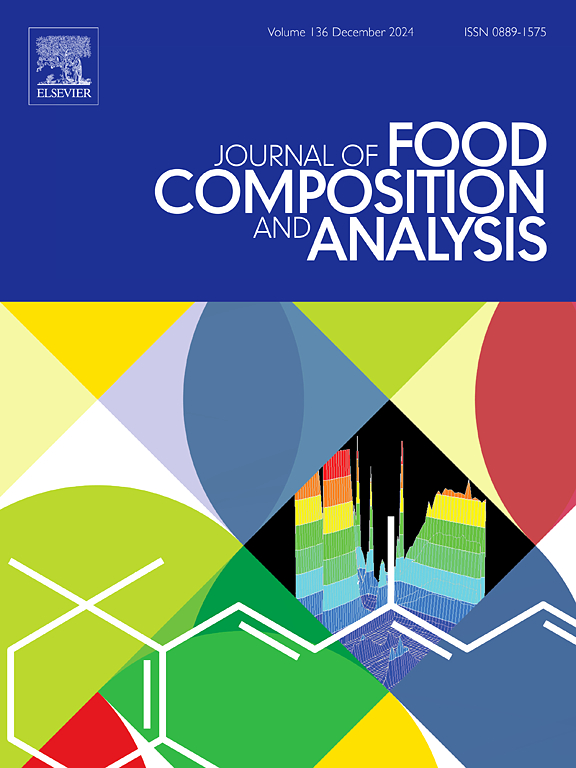5个养殖群体大口黑鲈肌肉和肝脏脂肪含量、脂肪酸谱和肝脏形态的比较分析
IF 4
2区 农林科学
Q2 CHEMISTRY, APPLIED
引用次数: 0
摘要
评估养殖鱼类的营养特性对提高养殖效率和质量至关重要。本研究对5个大口黑鲈(Micropterus salmoides)种群:“游鹿1号”(YL1)、“游鹿3号”(YL3)、安徽种群(ABP)、台湾种群(TBP)和普通种群(CBP)进行了表型性状、脂肪分布模式和脂肪酸谱分析。脂肪积累梯度显示肠系膜脂肪重量和腹腔脂肪比依次为CBP >; ABP >; TBP >; YL3 >; YL1。组织特异性脂肪含量差异显著:背肌(3.90 ~ 5.31 %)、腹肌(23.76 ~ 44.56 %)和肝脏(9.25 ~ 18.69 %),腹肌脂肪含量与肝脏脂质沉积密切相关。脂肪酸谱分析分别在背肌、腹肌和肝脏中鉴定出26、28和20种脂肪酸。CBP表现出平衡的SFA:MUFA:PUFA比例(营养最佳),而YL3表现出更好的心血管/抗氧化益处。不同人群对脂肪肝的易感性不同:YL3表现出严重的脂肪变性,其次是YL1、ABP和TBP,而CBP则保持健康的肝脏形态。组织形态计量学分析证实肝脏脂肪含量、液泡面积和脂滴密度呈正相关。本研究结果为优化大口黑鲈的脂肪含量、提高脂肪酸品质、缓解养殖中的肝脏问题提供了指导。本文章由计算机程序翻译,如有差异,请以英文原文为准。
Comparative analysis of muscle and liver fat content, fatty acid profiles, and hepatic morphology in five cultivated populations of largemouth bass (Micropterus salmoides)
Assessing nutritional traits of farmed fish is crucial for enhancing aquaculture efficiency and quality. This study evaluated phenotypic traits, fat distribution patterns, and fatty acid profiles across five largemouth bass (Micropterus salmoides) populations: "Youlu No. 1" (YL1), "Youlu No. 3" (YL3), Anhui population (ABP), Taiwan population (TBP), and common population (CBP). Fat accumulation gradients revealed mesenteric fat weight and intraperitoneal fat ratio ranked CBP > ABP > TBP > YL3 > YL1. Tissue-specific fat content varied markedly: dorsal muscles (3.90–5.31 %), abdominal muscles (23.76–44.56 %), and liver (9.25–18.69 %), and abdominal muscle fat content was strongly correlated with hepatic lipid deposition. Fatty acid profiling identified 26, 28, and 20 fatty acids in dorsal, abdominal muscles, and liver, respectively. CBP exhibited balanced SFA:MUFA:PUFA ratios (optimal for nutrition), while YL3 showed superior cardiovascular/antioxidant benefits. Populations differed in fatty liver susceptibility: YL3 displayed severe steatosis, followed by YL1, ABP, and TBP, whereas CBP maintained healthy liver morphology. Histomorphometric analysis confirmed positive correlations between liver fat content, vacuole area, and lipid droplet density. These findings guide largemouth bass selective breeding to optimize fat content, enhance fatty acid quality, and mitigate hepatic issues in aquaculture.
求助全文
通过发布文献求助,成功后即可免费获取论文全文。
去求助
来源期刊

Journal of Food Composition and Analysis
工程技术-食品科技
CiteScore
6.20
自引率
11.60%
发文量
601
审稿时长
53 days
期刊介绍:
The Journal of Food Composition and Analysis publishes manuscripts on scientific aspects of data on the chemical composition of human foods, with particular emphasis on actual data on composition of foods; analytical methods; studies on the manipulation, storage, distribution and use of food composition data; and studies on the statistics, use and distribution of such data and data systems. The Journal''s basis is nutrient composition, with increasing emphasis on bioactive non-nutrient and anti-nutrient components. Papers must provide sufficient description of the food samples, analytical methods, quality control procedures and statistical treatments of the data to permit the end users of the food composition data to evaluate the appropriateness of such data in their projects.
The Journal does not publish papers on: microbiological compounds; sensory quality; aromatics/volatiles in food and wine; essential oils; organoleptic characteristics of food; physical properties; or clinical papers and pharmacology-related papers.
 求助内容:
求助内容: 应助结果提醒方式:
应助结果提醒方式:


